What's new in Sculpt OS 23.04
With Sculpt OS 23.04 being in the wild since almost two weeks, it's time to put the spotlight on the most prominent changes.
You can find the latest Sculpt OS image along with up-to-date documentation here:
- Sculpt download page
- Up-to-date documentation
Presets of ready-to-deploy system scenarios
Earlier versions of Sculpt OS required elaborate manual steps to bring up a moderately interesting system. Because of this barrier of entry, the real beauty of Sculpt OS was all too easy to miss by casual reviewers. Now, Sculpt 23.04 comes with several examples by default, which allow you to instantly bring up a whole system composition at the convenience of a mouse click. The system menu at the upper-left screen corner reveals a couple of presets to play with. As a first test, you may load the nano3d preset.
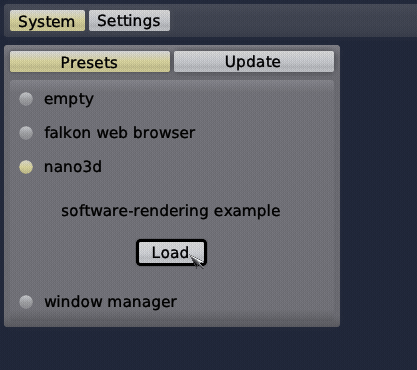
|
When initially loading a preset, Sculpt will automatically download all the needed ingredients on the selected (aka "used") file system and start the components. Sculpt's component graph makes the structure of the running system fully transparent to you. So you can see how each preset is composed. Once installed, the loading of a preset can be imagined as the boot into a separate operating system, but it takes only a fraction of a second, and you can switch between presets almost instantly. The example presets are:
- empty
-
Resets the runtime to the initial state.
- falkon web browser
-
Contains everything needed to run a disposable web browser. The browser lives completely in plain RAM, which you can verify by clicking on the falkon component in the graph. It is connected to the GUI, the network (NIC router), and the RAM file system but is not related to any storage device. The browser's audio and capturing interfaces are connected to the black-hole component, which mimics those devices without granting any hardware access.
- nano3d
-
A simple software-rendering demo useful as a bare-bones example.
- window manager
-
The scenario is meant as a starting point for an actually useful desktop system. It consists of the window-management components needed to properly remember your window positions and to use virtual desktops, and it spawns a system shell that gives you access to Sculpt's config and report file systems. Using the system shell, you can control and configure your system without relying on Sculpt's administrative user interface.
A few words about using the window manager in practice: By editing rw/recall/window_layouter/recall/rules using vim, you can directly manipulate the data model of the window manager, e.g., changing window positions, or assigning a window to a different virtual screen. You can go pretty wild, for example by making a backup of your rules file at one point, just to copy it back later to restore the original window arrangement. The window manager responds to the super key. To interactively switch between virtual screens, use super+1, super+2, etc., the maximized-state of the focused window can be toggled via super-enter, just to name the two most important shortcuts.
The presets feature is not only useful as an easy gateway for exploring Sculpt OS but it also allows you to craft different deploy configurations for the various use cases of your machine, and switch between these tailored system scenarios on demand.
The presets available in the system menu at the upper-left screen corner correspond to the files present at /config/presets/. Each file is a deploy configuration. You can turn the currently running system into a preset by copying /config/managed/deploy as new file to /config/presets/.
To keep your custom preset available after reboot, follow the usual pattern described in the documentation of Making customizations permanent by copying the file to /config/23.04/presets/ at your Sculpt partition.
On-target system update
Starting with version 23.04, Sculpt OS has become able to perform system updates interactively. With having your boot medium selected for the use by Sculpt, the system menu at the upper-left screen corner provides you with a convenient user interface for discovering and downloading new versions, and for switching between the installed system images.
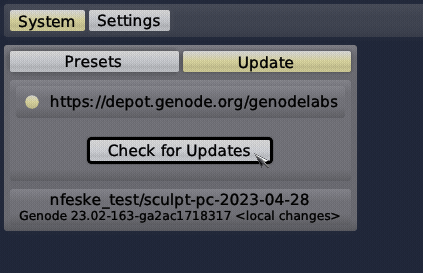
|
The upper part of the dialog allows you to select the system-image provider. By default, the provider is set to the one of your currently running system image. But you have to option to obtain images from alternative providers, or even add a new custom provider by using the "Edit" button. Under the hood, each listed provider corresponds a directory in your depot/ at the sculpt partition. When adding a custom provider, it will show up as a new directory there. The lower part of the dialog presents the information about the currently running system image for reference.
The check-for-updates button downloads the information about available images from the selected provider. This information is the presented along with the already downloaded images as exemplified in the following screenshot.
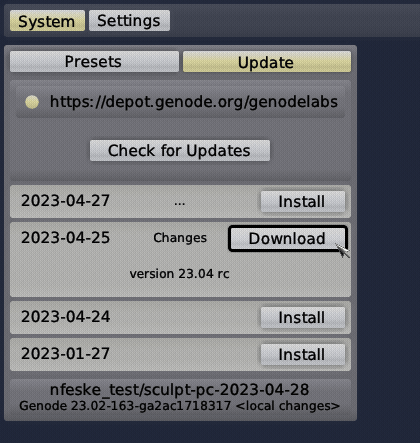
|
The little "..." dots indicate that change-log information is available when clicking on the entry. The download button fetches the image. Once fetched, the download button turns into an install button. You can select any present image for your next boot via the corresponding install button. Under the hood, this operation copies the content of the depot/<provider>/image/sculpt-<board>-<version>/ directory to your /boot/ directory. Note that you can switch back and forth between different versions this way. For example, should a new version not behave to your full satisfaction, you can easily switch back to the previous one by using the install button of the original version. As a precaution, it is good to have downloaded the initial Sculpt version you are using. In the worst case, should a new version fail to boot, you can still manually copy this downloaded original version from your local depot/ to your boot directory using a live USB system.
Once an image is installed, the dialog tells you "reboot to activate". One way to do that is by changing the system state in /config/system to "reset".
As a practical tidbit, the system image of Sculpt OS resides at the /boot/ directory of the "Genode" partition of the boot medium. E.g., when using a USB stick as boot medium on the PC, the boot directory resides on the 3rd partition of the USB stick. To update the Sculpt system image, make sure to have selected your boot partition for "use" by Sculpt. Should your boot medium differ from your regular Sculpt partition, e.g., when using an entire hard disk as one Sculpt partition, you may need to "un-use" your regular Sculpt partition and temporarily "use" your boot USB stick instead.
Mobile Sculpt OS on the PinePhone
For the first time, we have released Sculpt OS for two different CPU architectures simultaneously, namely 64-bit x86 and 64-bit ARM.
Besides the regular Sculpt OS image for the PC, we published a ready-to-use image for the PinePhone. It features a custom user interface, voice calls and mobile-data connectivity, wifi connectivity, device controls (battery, brightness, volume, mic, reset, shutdown), and a variety of installable software. Among the installable applications, there is the Chromium-based Morph web browser, an OpenGL demo using the GPU, tests for the camera and microphone, as well as a light-weight Unix-like system shell.
Thanks to the presets mechanism introduced above, the limited resources of the phone can be accounted and fully leveraged for each preset individually, while making the system extremely versatile. Here is an glimpse on the presets that come by default.
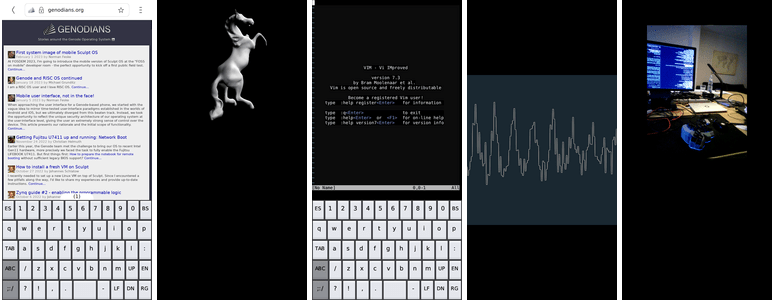
|
|
The variety of presets includes the Morph browser, GLMark2, a system shell, a simple oscilloscope, and camera test.
|
Beneath the surface of the mobile user interface, which we specifically designed for the touch screen of the phone, the underpinnings of the PinePhone variant are nearly identical to Sculpt OS on the PC. Speaking of the custom user interface, the functionality of Sculpt's + menu can be found in the software section of the UI. The following screenshot shows how a software provider can be manually added (left). Once added, the dialog allows you to browse the components offered by the selected provider.
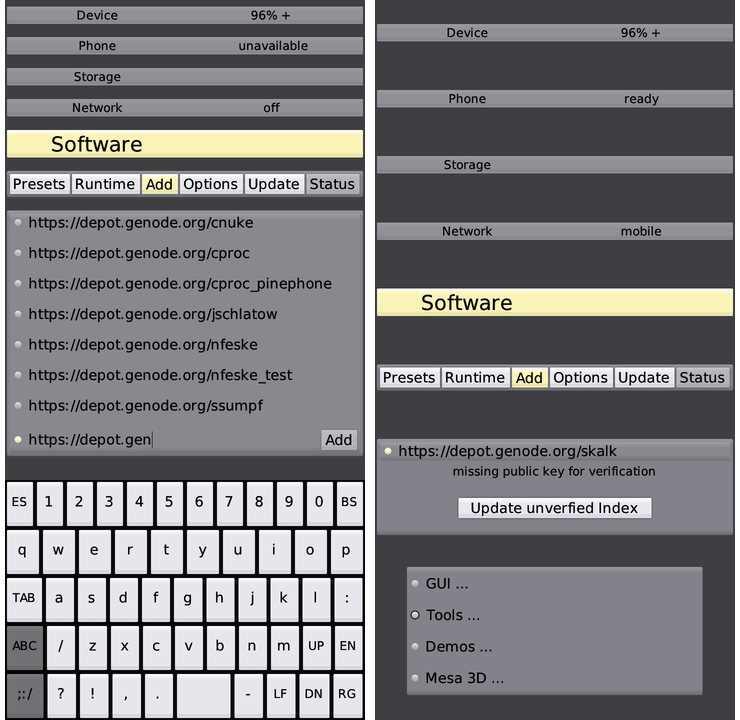
|
Once a component is selected, it can be downloaded and integrated into the system. The integration step resembles the freedom known from the PC version of Sculpt.
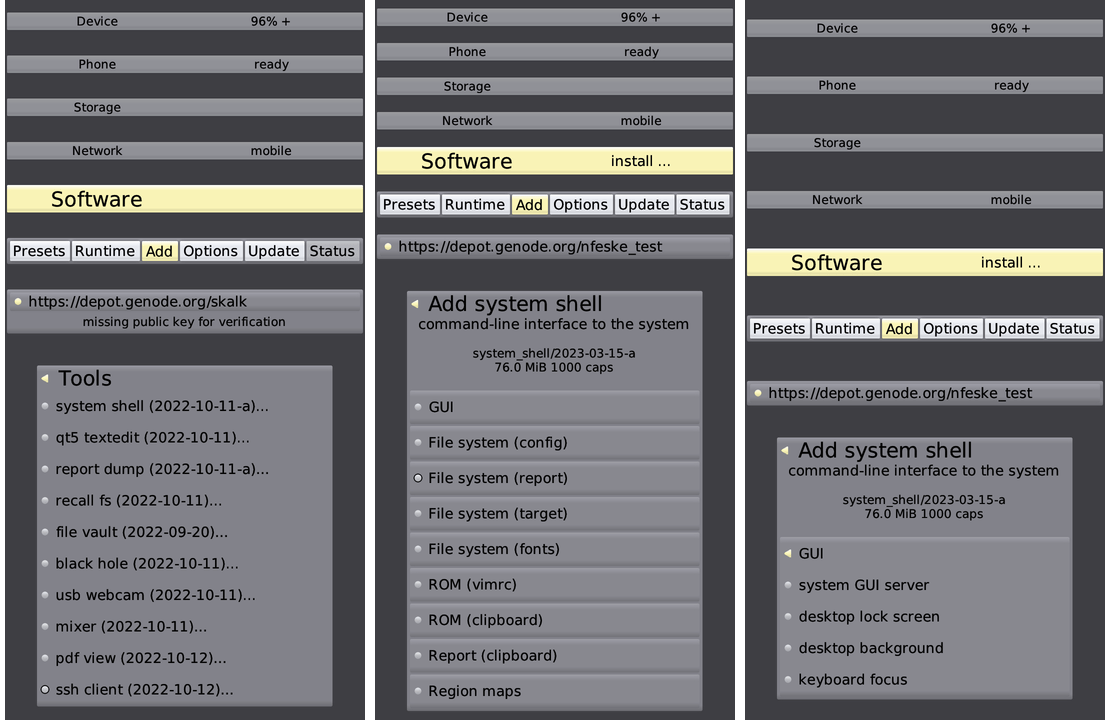
|
As a note of caution, the mobile variant of Sculpt OS is still incomplete in various respects. Please consider reading the dedicated posting to learn more about the current state of development.
Up-to-date drivers ported from Linux version 6.1.20
Sculpt OS leverages driver code ported from the Linux kernel for various peripherals such as Wifi, USB, display, or camera. But unlike Linux that executes all those drivers inside the monolithic Linux kernel, Sculpt runs each driver sandboxed in a dedicated component that is restricted to the specific device at hand.
For Sculpt OS 23.04, we updated all Linux-based drivers to the recent kernel version 6.1.20. So Sculpt users benefit from the enormous efforts of the Linux kernel community targeting modern hardware.


 Norman Feske
Norman Feske